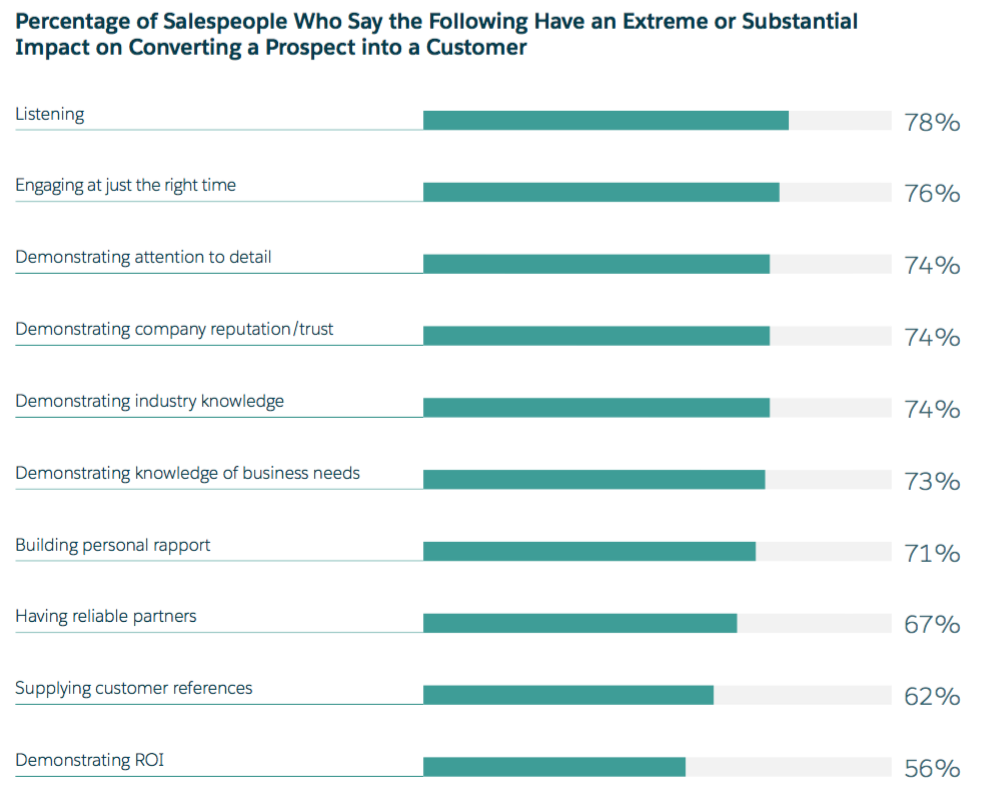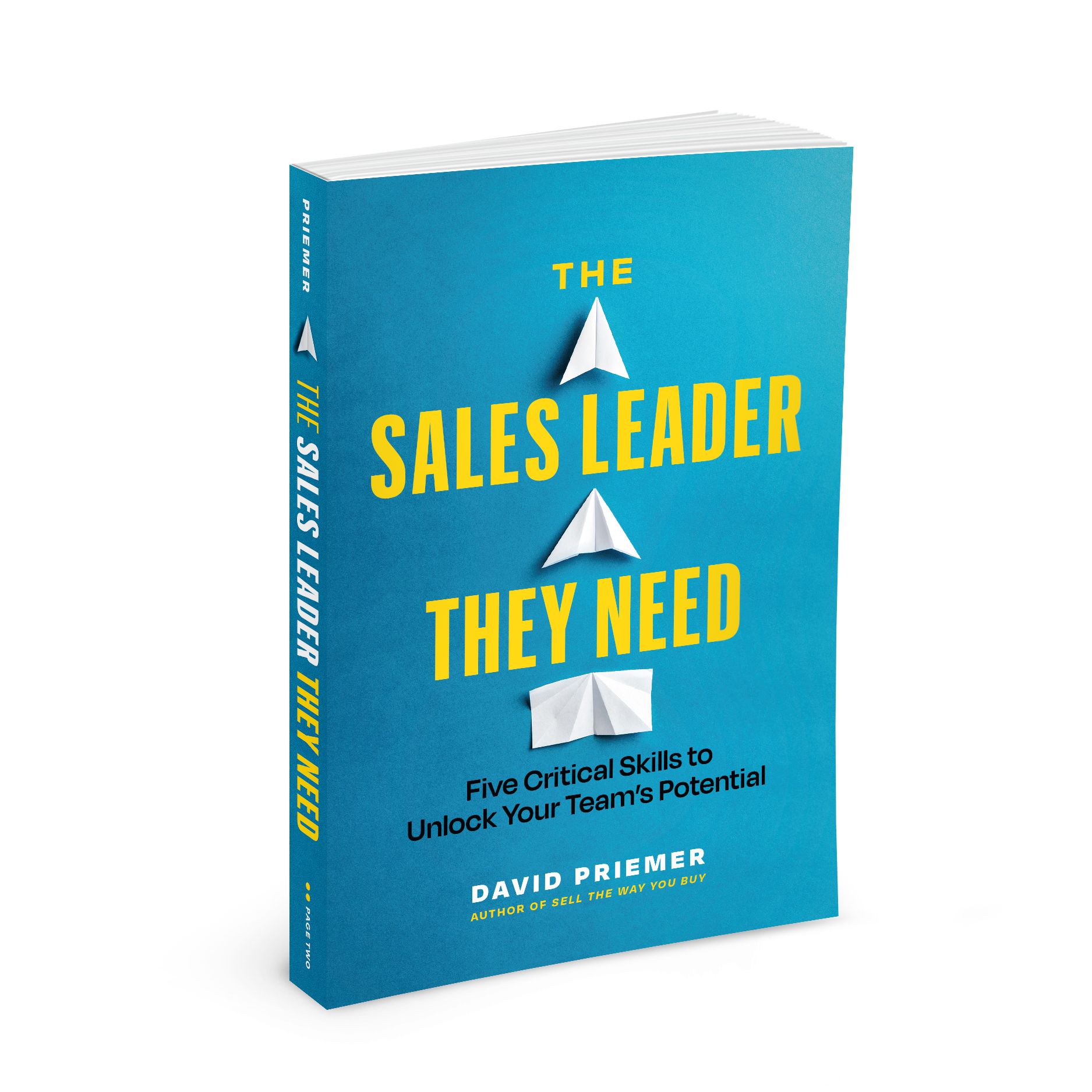5 Reasons Why HOW You Sell is More Important than WHAT You Sell
Imagine you made a reservation at one of the best restaurants in town to celebrate a special occasion. But when you arrive they have no record of it. After arguing with the host for ten minutes they finally agree to seat you. The food is amazing, but the service is slow, the server is rude, and the room is so noisy you can’t hear anyone else at your table. Hours later you leave the restaurant angry, upset, disappointed.
This is precisely the lackluster experience that you could be setting your customers up for if you focus your sales motion on solutions, features, and benefits instead of feelings, mindset, and preparation!
Here are five reasons why HOW you sell is more important than WHAT you sell when it comes to converting modern buyers.
1. The buying experience IS your product
Make no mistake. We’re living in an experience economy which is why no matter what you’re selling or who you’re selling it to, the experience your customer has with you or your organization IS your product!
Don’t believe me? Then answer me this! Suppose you wanted to buy a new iPhone. Would you rather buy those it at your local Apple store or big box electronics store? If you said the Apple store, you’re not alone. Apple works very hard to create a specific vibe, atmosphere, and arguably “cooler” buying experience (for exactly the same product) than other retailers.
Gartner reports that companies that deliver a great buying experience grow two times faster than those that deliver average experiences. Salesforce’s State of the Connected Customer report agrees, stating that 80% of customers feel the buying experience a company provides is as important as its products and services. So if you want to sell more, you need to create a high-value and frictionless experience during the sales cycle that transcends the business value customers get from your solution.
Related article: How To Sell More by Nailing the Buying Experience
2. How you prepare and show up matters!
An experienced personal trainer told me that 90% of the success formula in his line of work is simply being on time, organized, prepared, and attentive to your clients. In the sales game that means things like:
- Did you review and internalize the notes from your previous meetings?
- Did you do your homework before speaking to the client to understand their business?
- Did you send a meeting summary in writing and follow up on the agreed-upon next steps?
Even basic human behaviors like listening can be massively impactful to your customer’s experience.
In Salesforce’s State of Sales Report, when salespeople were asked to list factors that they felt had an extreme or substantial impact on converting a prospect to a customer, listening topped the list while demonstrating ROI was tenth!

In his popular TEDx talk, “The Power of Listening”, Getting to Yes author, William Ury illustrates how the simple act of attentive listening helps us better understand and connect with others. Listening also has the added benefit of invoking feelings of reciprocity. When we listen to people and demonstrate an interest in their content and consideration of their feelings, it makes it more likely that they’ll want to listen to us.
And the best part about leveraging all these selling basics to create a high-impact buying experience; they require zero talent only practice and discipline.
Related article: Do Your Homework! 3 Reasons Why Science Says Personalization Drives Results
Related article: 5 Tips for Mastering the Art of Listening in Sales
3. Buyers expect you to add value BEYOND your solution
According to Forrester, 60% of buyers prefer not to interact with a sales rep as the primary source of information; 68% prefer to research on their own, online; and 62% say they can now develop selection criteria or finalize a vendor list based solely on digital content. That means that when they DO decide to interact with a salesperson, they expect you to deliver value beyond the information they can find online.
In fact, according to Gartner, 88% of account managers believe servicing accounts above and beyond customer expectations is the surest way to grow.
Unsure whether you’re delivering a top-tier experience to your customers beyond your solution? Ask yourself this;
Would my prospective customers feel our interaction was valuable, even if they don’t end up buying from me?
- Do I provide customers insights into industry trends?
- Have I shared any free, helpful resources with my customers?
- Can I make an introduction to someone else who could help my customer?
- Is there a book or event I could recommend that my customer might find helpful?
Given that the timing won’t always align for you and your buyers to do business together, ensuring you create a valuable buying experience will significantly increase the likelihood that your customers respond to any future outreach. Or better yet, call you when the time is right.
Related video: How to use reciprocity to stop prospects from ignoring you
4. Your tone and approach transcends your tactics
The tone and approach with which a sales tactic is delivered can have a huge impact on how the customer sees you. For example, suppose a buyer is deciding between your product and someone else’s when they come back to you and say “I like your product, but it costs twice as much as your competition.” How do you respond?
You could try to use a reverse psychology tactic to test the customer’s resolve, saying something like “Okay! Why don’t you just go and buy their solution then?” Alternatively, you might respond with something more thoughtful like, “It’s true, we’re not the least expensive option on the market and we’re certainly not for everyone. If you don’t mind me asking, why might you lean away from purchasing the other solution?”
The science on which the tactic is based is the same in both cases. But the tone of the first approach can come off as arrogant and antagonistic and make your customer angry. The second is agreeable, curious, and demonstrates a sense of caring. In the same way, choosing to bash your competition by knocking their solution or customer experience can equally damage your sense of professionalism and turn customers away.
Even the way you ask your discovery questions can impact how buyers see you. Buyers hate what I call “polite interrogation”; where they feel you’re working down your prepared list of questions and hitting them with them one by one. But you can make your customer feel totally comfortable answering even the most intimate questions by controlling the tone and pacing of your delivery.
Related article: 5 Tips for Talking About Your Competition
Related article: Don’t Fall Into These 3 Discovery Question Traps!
Related video: The way you ask questions matters!
5. People don’t buy products, they buy feelings
From the food you eat to the car you drive and the clothes you wear, people rarely make decisions that perfectly align with our logical interests. But we always do what we feel! In a study entitled, The New Science of Customer Emotions, researchers showed that the emotions that drive buying behaviors often reflect deep, unspoken emotional needs.
That’s why great salespeople don’t sell products. They sell feelings!
One of the easiest ways to shift to a feelings-focused sales motion is to ditch your traditional product-based sales pitch and lead with problems instead. These and similar scientifically proven approaches can quickly break through your customer’s armor, stirring a massive amount of positive emotions in their minds and moving them to convert faster!
Related article: Salespeople: Don’t Confuse Value with ROI
Related article: To Win More Deals, Lead with Problems Not Solutions. Here’s Why.
Related video: Don’t Sell Solutions, Sell Feelings!
In a world with a seemingly endless marketplace of similar-sounding solutions, the key to sales success lies in being able to differentiate not only on your product but on the buying experience itself. If this hasn’t been a focus for your sales organization in the past, try to focus on one of these areas at a time and look to make improvements.
PS – Did you like these approaches and want to learn more like them? Check out the popular Cerebral Selling Sales Academy training program!
We promise never to send you junk or share your email! Just helpful sales insights.














Well worth a read. Got great insights and information from your blog. Thanks.
Number 1 and 5 is the reason I refused to make a recent purchase for a vintage sewing machine from a website. The seller was very short and precise with me, focusing only on the product features and how the sale benefitted the seller in the end. I politely ceased the deal thinking, “Why should I give you my money when all I receive from you is a dull and lifeless interaction?”
Hi David,
The post is looking amazing. Selling things is art. All the 5 points are looking really good and explained very well. For a good seller, it is important to become a good learner so that we can implement things and get the best process.
Thanks